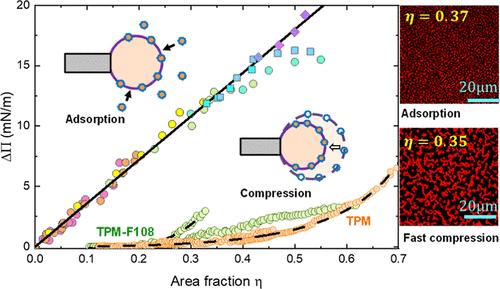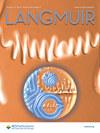Distinct Contributions of Particle Adsorption and Interfacial Compression to the Surface Pressure of a Fluid Interface
IF 3.7
2区 化学
Q2 CHEMISTRY, MULTIDISCIPLINARY
引用次数: 0
Abstract
Particle-laden interfaces stabilize emulsions and foams and can serve as a platform for multiscale materials. Favorable wetting of a particle to a fluid interface reduces the apparent interfacial tension through area replacement with a linear relationship between the apparent surface pressure and the particle area fraction. The area replacement model is widely employed, often up to particle area fraction reaching the maximum hexagonal packing. However, data directly supporting the area replacement model are limited, and the description ignores contributions from particle–particle interactions and does not describe the surface pressure during the compression of a particle-laden interface. This work reports on the direct validation of the area replacement model through the direct measurement of the adsorption energy, surface pressure, and area fraction of adsorbed particles. Experiments combining tensiometry and confocal imaging during the adsorption of colloidal particles to the oil–water interface confirm the area replacement model within the observed range of area fraction, but only when the drop area is kept constant. Results highlight the importance of keeping the droplet area constant during particle adsorption to extract the adsorbed amount from tensiometry experiments. As particles adsorb to the interface, the droplet area tends to change and compresses or expands the interface. This change in area is associated with an increase in area fraction at nearly constant surface pressure, which deviates from the area replacement model. In contrast to particle adsorption, slow compression of the fluid interface leads to a negligible change in surface pressure up to an area fraction of η ∼ 0.26 for the materials systems investigated. Increase in surface pressure during compression is due to particle–particle interactions, while compression at higher strain rates introduces additional contributions from interfacial rheology.

颗粒吸附和界面压缩对流体界面表面压力的不同贡献
含有颗粒的界面可稳定乳液和泡沫,并可作为多尺度材料的平台。颗粒与流体界面的良好润湿可通过面积置换降低表观界面张力,表观表面压力与颗粒面积分数之间存在线性关系。面积置换模型被广泛采用,通常颗粒的面积分数可达到最大六方填料。然而,直接支持面积置换模型的数据非常有限,而且该模型忽略了颗粒与颗粒之间的相互作用,也无法描述含有颗粒的界面压缩过程中的表面压力。本研究报告通过直接测量吸附能量、表面压力和吸附颗粒的面积分数,直接验证了面积置换模型。在胶体颗粒吸附到油水界面的过程中,结合张力测量和共聚焦成像进行的实验证实了面积置换模型在观察到的面积分数范围内的有效性,但只有在液滴面积保持恒定的情况下才能实现。结果凸显了在颗粒吸附过程中保持液滴面积恒定对于从张力测量实验中提取吸附量的重要性。当颗粒吸附到界面时,液滴面积往往会发生变化,并压缩或扩大界面。在表面压力几乎不变的情况下,这种面积变化与面积分数的增加有关,这偏离了面积置换模型。与颗粒吸附相反,在所研究的材料体系中,流体界面的缓慢压缩导致表面压力的变化微乎其微,最高可达面积分数 η ∼ 0.26。压缩过程中表面压力的增加是由于颗粒与颗粒之间的相互作用,而较高应变速率下的压缩会带来界面流变学的额外贡献。
本文章由计算机程序翻译,如有差异,请以英文原文为准。
求助全文
约1分钟内获得全文
求助全文
来源期刊

Langmuir
化学-材料科学:综合
CiteScore
6.50
自引率
10.30%
发文量
1464
审稿时长
2.1 months
期刊介绍:
Langmuir is an interdisciplinary journal publishing articles in the following subject categories:
Colloids: surfactants and self-assembly, dispersions, emulsions, foams
Interfaces: adsorption, reactions, films, forces
Biological Interfaces: biocolloids, biomolecular and biomimetic materials
Materials: nano- and mesostructured materials, polymers, gels, liquid crystals
Electrochemistry: interfacial charge transfer, charge transport, electrocatalysis, electrokinetic phenomena, bioelectrochemistry
Devices and Applications: sensors, fluidics, patterning, catalysis, photonic crystals
However, when high-impact, original work is submitted that does not fit within the above categories, decisions to accept or decline such papers will be based on one criteria: What Would Irving Do?
Langmuir ranks #2 in citations out of 136 journals in the category of Physical Chemistry with 113,157 total citations. The journal received an Impact Factor of 4.384*.
This journal is also indexed in the categories of Materials Science (ranked #1) and Multidisciplinary Chemistry (ranked #5).
 求助内容:
求助内容: 应助结果提醒方式:
应助结果提醒方式:


